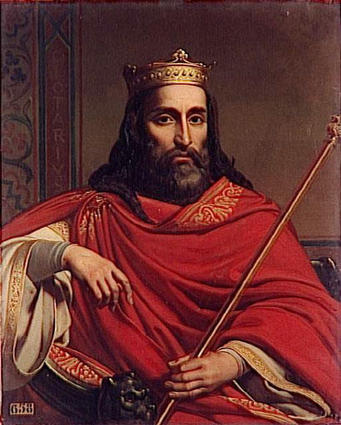
Duke William of Normandy had the sanction of the church for his expedition, and this is shown heraldically by the banner depicted in the Bayeux Tapestry; a red cross on a white background with a blue border. This was the flag that received the blessing of Pope Alexander. Although enjoying the support of the Church, William was by no means subservient to the Pope’s wishes, as in later years he said the following to Pope Gregory: “ Fealty I never willed to do, nor do I will to do it now. I have never promised it, nor do I find that my predecessors did it to yours.” Another Norman banner represented in the Bayeux Tapestry may have been the famous raven of the Norsemen. This emblem recalls the descent of the Normans from the fierce and adventurous Scandinavian people who harried the shores of Britain and Ireland and established themselves firmly in Northern France during the ‘dark ages’ after the fall of Charlemagne’s Empire. It suggests that the Normans acknowledged their origins and emphasizes the fact that the Anglo-Saxon kingdom finally fell not to a new and unexpected foe, but to a branch of that race which had for generations sought to conquer it.

WILLIAM THE CONQUERER
.
An armed knight holding a red banner containing two golden lions ( the traditional arms of the Conqueror) supports the shield of the Delaval family, and represents Guido de la Val, said to have been a cousin of Duke William of Normandy, and to have borne his head banners at the Battle of Hastings in 1066. Other families that cling to the legend of an ancestor that fought at the Battle of Hastings seek to support their claim by a liberal interpretation of the bearings in their Arms. A branch of the St. Johns who display three wagon horses’ collars profess to be descended from the master of William’s baggage- wagons; and the Ferrers family seek the origin of their name, and the horseshoes in their shield in the office of chief farrier to the Norman army. The surname Fortescue is attached to a romantic story from the Battle of Hastings. Richard le Fort, it is told, flung his shield before Duke William at a critical moment in the battle, saving William from certain death. For this service to the Duke, Fort received the addition of escue to his name, and to this day the Fortescues bear the punning motto Forte scutum salus dictum --“ A strong shield is the leader’s safeguard.” A badge of the family is a shield bearing the word “Fort”. The need for certain families to establish a Norman ancestor has been responsible for many such fables, and to correct this is an apt quote from the foremost authority on heraldic matters, Arthur Fox-Davies in his book Armorial Families: “If any ordinary individual tell you he is descended in the male line from someone who figures upon the glorious roll of Battle Abbey, or that his ancestor ‘came over with the Conquerer’, write him down a perverter of the truth at once.”



